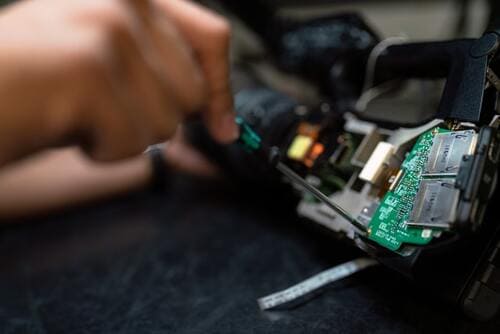Fiber Bragg gratings (FBGs) are commonly applied in different fiber optic devices, for instance, in fiber lasers, sensors, etc. However, because of the harsh environmental conditions, where FBGs are operating, there are several important factors that should be taken into consideration.
According to the experiments and field results, FBGs’ characteristics can change with time. Negative environmental effects such as radiation and hydrogen effects can not only influence the parameters but also shorten the operation time of the fiber Bragg gratings. It is especially important to understand the radiation effects and other factors on essential dimensions of fiber optic systems during fiber optic technology manufacturing.

What are the Fiber Bragg Gratings (FBGs)?
Fiber Bragg grating is an optical fiber that has the refraction index changing along the fiber length. Due to its modulation, FBG acts as a mirror that reflects certain wavelengths and transmits the others.
FBGs have become significant tools of the fiber optic technology from the very first day of their creation. Specialists have drawn much attention to the fiber optic sensing because of its properties, for example, compact sizes, immunity to the electromagnetic interference, etc.
What are the applications of the FBGs?
Specialists have already applied fiber optic solutions in various industrial sectors: industrial and civil constructions, aerospace, etc. Fiber optic sensors are applied for measurement of different physical parameters including temperature, strain, pressure, etc. Nowadays, these abilities are effectively applied in such structures as a structural health monitoring device by fiber Bragg grating sensors.
However, implementing such a powerful instrument in difficult environmental conditions, where most tools can not be used at all, brings some troubles. Scientists have learned to deal with it and have improved fiber Bragg gratings greatly.
So, nowadays FBGs are capable of operating in high radiation conditions, as an example, for nuclear installations and space applications.
Fiber Bragg gratings (FBGs) for space
The most up-to-date fiber optic sensors can be used not only for spacecraft systems, but also for astronauts’ security and health. In space, the radiation level is very high, taking into consideration the periodic solar flares.
There is a need for an accurate system that is able to operate in radiation environments. Especially, considering the fact that it brings some troubles even to replace some equipment onboard not to tell about when a satellite is put into orbit.
That’s why fiber optic systems are highly suitable for applying in this industry and providing data about temperature, strain and radiation. Moreover, based on the received information, it can foresee possible malfunctions. They are able to operate in extreme conditions and survive during the entire mission.
These factors make all the difference in future space exploration and its colonization.
FBGs for the nuclear industry
Fiber Bragg grating sensors can be also implemented for the development of nuclear applications. It is well-known that the radiation affects the surrounding materials and consequently their features. It is about photonic and electronic components that are the most susceptible to nuclear radiation exposure.
Usually, in the nuclear industry there is no possibility to replace components or make any repairs of the already operating systems. That’s why it is required to monitor the systems’ maintenance in the radiation conditions.
There are two types of radiation that are always taken into consideration: gamma-rays and neutrons. Gamma-rays are radiated by the surrounding structures, and neutrons are relevant to the inner reactor core during its operation. FBGs can be implemented in different sensing operations. For example, monitoring of the temperature in the reactor core and observation of the underground nuclear waste storage facilities, mechanical stress measurements, etc.
FBGs in radiation environments
There are several types of FBGs that can be divided according to their diverse inscription processes, thermal and radiation resistances. In reality, fiber optic sensors can malfunction under the long-term exposure of radiation that leads to the future measurement errors. These malfunctions depend on the structure of distributed fiber optic sensors and the radiation environment.
Scientists have conducted a range of special studies to watch how fiber Bragg gratings are operating in radiation conditions. Space, high energy physics and nuclear facilities are able to apply fiber optic technology to their advantage.
Fiber optic sensors’ sensitivity to the radiation depends on their way of manufacturing and concentration. However, ionization is able to break the bonds. Moreover, there is a possibility of structural changes such as densification that causes further defects. These factors lead to the degradation of optical characteristics that are invisible to the eye.
The main effect applied in this technology is radiation-induced attenuation. It depends on various parameters including:
- Harsh environments;
- Qualities of the optical fibers like manufacturer process, etc;
- Testing environment.
Due to the composition of the optical fibers, they will react in radiation environments differently. That’s why except for the accurate calculations, specialists take tests on the fiber radiation response in conjunction with temperature. They watch fiber optic sensors’ possible reactions before applications in the real-world environment.
Fiber Bragg gratings have many capabilities and can be applied for prevention of disasters and accidents. With a proper coating and method of inscription, FBGs are able to detect any changes and, due to it, define the concentration of the hydrogen, etc. The quick and accurate location of the resulting leakage can prevent crucial damages, unexpected expenses, and danger to human life.
Optromix is a fast-growing vendor of fiber Bragg grating (FBG) product line such as fiber Bragg grating sensors, for example, FBG strain sensors, FBG interrogators and multiplexers, Distributed Acoustic Sensing (DAS) systems, Distributed Temperature Sensing (DTS) systems. The company creates and supplies a broad variety of fiber optic solutions for monitoring worldwide. If you are interested in structural health monitoring systems and want to learn more, please contact us at info@optromix.com










 It is not a secret that fiber optic technology already has a wide range of different applications starting with medicine and ending with road monitoring. However, scientists still have a lot of spheres for FBG sensors implementation. And the VR ecosystem is one of them.
It is not a secret that fiber optic technology already has a wide range of different applications starting with medicine and ending with road monitoring. However, scientists still have a lot of spheres for FBG sensors implementation. And the VR ecosystem is one of them.